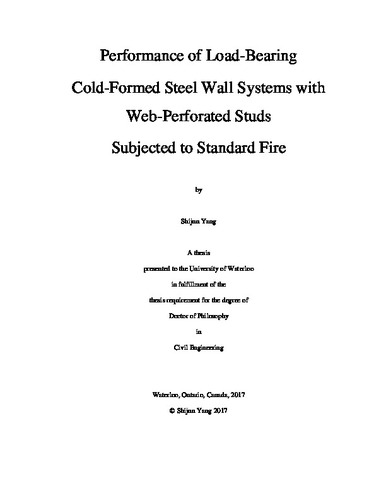| dc.description.abstract | Load-bearing cold-formed steel (CFS) wall systems are commonly constructed with CFS C-shape studs with one or two layers of fire-rated sheathing attached to both sides. In practice, perforations are placed in stud webs to accommodate the passage of utilities or installation of intermediate braces. These walls may fail by local buckling at the web perforations, combined with studs bending towards the furnace, as demonstrated by several full-scale fire tests. Current understanding of fire performance of such walls with web-perforated studs remains relatively limited, and the effect of web perforations on the fire resistance have not yet been accounted for in current design methods.
Finite element analysis (FEA) using the software ABAQUS, an alternative to full-scale fire tests, was employed to investigate the heat transfer and structural responses of CFS walls. Three-dimensional heat transfer models were developed and validated with full-scale fire tests. Parametric studies demonstrate that for insulated CFS walls, web perforations induce a larger temperature gradient in perforated cross sections than in the solid ones along the stud length; however, for non-insulated CFS walls, the effect of web perforations on the temperature distributions in stud cross sections is negligible.
Sequentially uncoupled 3D FE thermal-stress models were developed to evaluate the fire performance of load-bearing CFS walls with web-perforated studs. These walls were partially insulated, sheathed by double layers of MgO board or Type C gypsum board, and by mixed Type X and MgO board. Unlike in previous studies, temperature distributions incorporated into the structural model were obtained from heat transfer analysis so as to include the difference in temperature distributions caused by web perforations. Three models were developed: (1) a CFS wall stud model, as in previous studies. The predicted failure time is acceptable when compared with that of full-scale fire testing. (2) a CFS wall frame model. Stiffness and force interactions among the CFS wall studs were considered. The middle few studs of the wall frame may bear higher loads than that applied to a single stud, demonstrating that the single stud model may overestimate fire resistance. Thus, the stiffness and force interactions should be considered in the FEA to achieve better accuracy. (3) a CFS wall system model. Sheathing, attached to CFS wall framing, may enhance the load carrying capacity of walls. Such an increase in load carrying capacity is permitted and can be evaluated in the design of CFS walls at ambient temperature. However, the effect of using sheathing to brace to wall studs has not been investigated at elevated temperature. Modelling sheathing using shell element, in addition to the CFS wall frame, provides more realistic prediction of the structural response of full-scale fire tests than the above-mentioned two models.
A simplified design method is extended for CFS web-perforated studs in walls, subjected to standard fire, based on effective width method as stated in the North American Specification for the Design of Cold-Formed Steel Structural Members (AISI S100). CFS wall studs are subjected to combined compression and bending due to neutral axis shift, thermal bowing and their magnification effects. A plate buckling coefficient, accounting for the web perforation length and width, is introduced to characterize the nominal axial strength. The effect of web perforations on the nominal flexural bending is ignored, as is consistent with AISI S100 (2012) at room temperature and parametric study results at elevated temperature. The limit of web perforation length is extended from the 114 mm, specified in AISI S100 at room temperature, to 130 mm at both room and elevated temperatures. The accuracy of the proposed design equations is acceptable when considering the complexity of the problem being dealt with and the simplicity of the calculation. | en |

